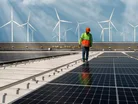Sustainable Manufacturers Harness On-Site Energy Generation

A new report from the International Energy Agency shows that electricity demand is expected to grow over the next three years across the world. Yet the extra demand is forecast to be covered by clean energy technologies.
Npower is one such company seeking to provide green energy to customers. Specifically for its manufacturers, npower encourages the installation of on-site energy generation, which can help to source flexible power, reduce carbon emissions and help manufacturers become more energy-resilient.
The role of on-site energy generation in manufacturing
npower Business Solutions (nBS) is a leading provider of energy supply and solutions, serving around 24,000 industrial and commercial customers, with more than 237,000 sites. nBS offers energy management solutions from metering and data collection services to monitoring and targeting software, energy efficiency expertise and carbon-reduction support, helping businesses buy and use energy more efficiently.
“Business demand for renewable energy is only set to grow,” says Vish Sharma, Head of Power Purchase Agreements at npower Business Solutions (nBS). “As a result, independent energy generators, including manufacturers with on-site assets, will undoubtedly play an important role in both supporting the growth of homegrown clean energy and in meeting the growing demand from businesses who want to procure their power from renewable sources.”
Manufacturers who are interested in installing an on-site generation asset have multiple options to choose from, but the most suitable of these will depend on the size of the premises, its location and the feasibility of installation.
“Industrial and commercial sites that use large quantities of heat and power may be suitable for a combined heat and power (CHP) unit,” says Sharma. “This provides on-site electricity generation while the heat produced from the process is captured and used elsewhere in your building. It works by converting fuel into electricity through a generator to power on-site operations.”
In addition to that, manufacturers with an on-site energy asset can sell their excess power to other businesses who are eager to purchase zero carbon energy from a reputable source.
Selling renewable energy for manufacturers with on-site generation assets
There are various routes for those manufacturers who own an energy generation asset, or are considering investing in one, to sell their power to business energy buyers.
“When your asset is up and running, you’ll be in a position to assess how much power could be sold to other businesses. The best route to market for this power is via a fixed or flexible Power Purchase Agreement (PPA),” explains Sharma.
PPAs are contracts that agree energy production output and its subsequent purchase. They are made between asset holders who generate renewable power and commercial buyers. In short, they are a valuable route to market for generators to sell their power.
As an established method of managing energy sales and risk in generation projects, PPAs encompass all the commercial terms required to deliver a route to market for generation. They include start date, delivery schedules, pricing mechanisms, and payment terms and can include renewable certificates such as Renewable Obligation Certificates (ROCs) and Renewable Energy Guarantees of Origin (REGOs). They are usually valid for several years and offer pre-set or to-be-determined prices for energy purchases.
“Importantly, a PPA can cover an existing generation asset or provide assurance and confidence to investors in the financing of new renewable projects,” says Sharma. “PPAs can therefore be agreed upon before a project becomes fully functional.”
When it comes to selling power, deciding which PPA is best can be complex and is based on a range of factors, including:
Annual output
“Fixed PPAs can be a good choice for generators with a limited annual output. However, if your annual output is 6 GWh or more, flexible PPAs could offer a better route to market,” says Sharma.
The nature of your generation
“Some renewables, such as biomass power, offer a steadier output regardless of weather conditions. Others, like wind and solar PV, are more intermittent and weather-dependent.”
Time constraints and risk appetite
“The energy market is complex, and your familiarity with it can be a deciding factor when choosing the best PPA for your asset.”
Long term objectives
“Whether you want a steady and risk-free revenue stream or wish to optimise profits with a flexible agreement, your goals will ultimately determine which PPA is best for you,” says Sharma.
According to Annie Scanlan, Policy and Impact Director at RE-Source, corporate PPAs in Europe rose 55% in 2023, to reach a new high of 10.4 GW of contracted capacity. Solar energy deals were the most popular form of green energy used.
******
Make sure you check out the latest edition of Manufacturing Digital and also sign up to our global conference series - Procurement & Supply Chain 2024 & Sustainability LIVE 2024
******
Manufacturing Digital is a BizClik brand.
- Panasonic Opens First European Demo Renewable Power FacilitySustainability & ESG
- Digitalisation as a Strategy to Attract and Retain WorkersDigital Factory
- UPDATED VENUE & DATE – Manufacturing LIVE Chicago 2025Sustainability & ESG
- ABB Cuts Industrial E-Waste in Quest for CircularitySustainability & ESG


